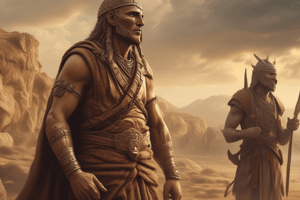Podcast
Questions and Answers
Match the following phases of human history with their characteristics:
Match the following phases of human history with their characteristics:
Nomadic, hunter-gatherer = Lifestyle before the Neolithic period Settled agriculture and animal domestication = Characteristic of the Neolithic period Complex societies and social hierarchies = Emergence in the Neolithic period Full-scale industrialization = Not a characteristic of the Neolithic period
Match the following regions with their significance during the Neolithic period:
Match the following regions with their significance during the Neolithic period:
The Fertile Crescent = Region where the Neolithic period originated The Middle East = Part of the Fertile Crescent region Egypt = Part of the Fertile Crescent region Turkey = Region where the city of Çatalhöyük was located
Match the following species with their characteristic during the Neolithic period:
Match the following species with their characteristic during the Neolithic period:
Homo sapiens = Species that developed agriculture and animal domestication Other hominids = Species that had already gone extinct Animals = Species that were domesticated during the Neolithic period Plants = Species that were cultivated during the Neolithic period
Match the following Neolithic period characteristics with their effects:
Match the following Neolithic period characteristics with their effects:
Match the following locations with their characteristics during the Neolithic period:
Match the following locations with their characteristics during the Neolithic period:
Match the following time periods with their significance:
Match the following time periods with their significance:
Match the following domesticated crops with their characteristics:
Match the following domesticated crops with their characteristics:
Match the following domesticated animals with their primary uses:
Match the following domesticated animals with their primary uses:
Match the following Neolithic developments with their effects on society:
Match the following Neolithic developments with their effects on society:
Match the following Neolithic architectural structures with their characteristics:
Match the following Neolithic architectural structures with their characteristics:
Match the following Neolithic societal developments with their indicators:
Match the following Neolithic societal developments with their indicators:
Match the following innovations with their primary benefits:
Match the following innovations with their primary benefits:
Flashcards are hidden until you start studying
Study Notes
-
The Neolithic period marks a significant turning point in human history, where humans transitioned from a nomadic, hunter-gatherer lifestyle to one of settled agriculture and animal domestication.
-
This period saw the emergence of two of the most revolutionary inventions in human history: agriculture and animal domestication, which transformed the way humans lived and interacted.
-
The Neolithic period was exclusive to Homo sapiens, as other hominids had already gone extinct, and only Homo sapiens possessed the intellectual capacity to develop such innovations.
-
The origins of the Neolithic period can be traced back to around 10,000 BCE in the Fertile Crescent, a region that includes the Middle East and Egypt.
-
The Fertile Crescent was characterized by its fertile soil, abundant water sources, and diverse wildlife, making it an ideal location for early agricultural experiments.
-
The development of agriculture and animal domestication allowed for population growth, which in turn led to the emergence of more complex societies and social hierarchies.
-
In the Neolithic period, humans began to settle in permanent locations, forming small villages and towns, and eventually, cities like Çatalhöyük in modern-day Turkey, which covered an area of 13 hectares and housed a population of 5,000 to 8,000 people.
-
The economy of the Neolithic period shifted from a hunter-gatherer, subsistence-based economy to a productive economy, where humans created their own food through agriculture and animal husbandry.
-
The first domesticated crops included wheat, barley, and legumes, while animals like sheep, goats, and pigs were domesticated for their meat, milk, and hides.
-
The emergence of agriculture and animal domestication led to the development of trade and commerce, as people began to exchange goods and services with one another.
-
The invention of ceramics, which allowed for the storage of food and other goods, also facilitated trade and commerce.
-
The Neolithic period saw the emergence of megalithic architecture, characterized by the construction of large stone structures, such as menhirs, cromlechs, and dolmens, which were often used for religious or ceremonial purposes.
-
The construction of these megaliths required significant communal effort and organization, indicating that the societies that built them were large, complex, and well-organized.
Studying That Suits You
Use AI to generate personalized quizzes and flashcards to suit your learning preferences.




